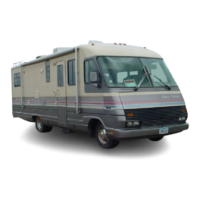.','
. ,
Dinette
Conversion
To
convert
the
dinette
into
a bed:
• Unfasten and remove cushions.
• Reach under
the
table, fold
the
leg up under
the
table top.
• Raise
front
portion
of
table several inches
to
disengage inserts
from
the
wall supports.
• Lower table
top
to
the
dinette frame
to
complete
bed base.
• Slide
seat
and back cushion
into
place over bed
base.
Sofa/Lounge Conversion
To
convert a sofa/lounge
into
a bed:
• Remove sofa bolsters.
•
Lift
front.
of
sofa frame up and
out.
.'
Pusn
the
back
of
the
lounge back and down, .
•
Push
the
seat belts
through
the
space
between.
the
lounge back and seat.
To
restore
the
sofa/lounge:
• Pull
the
seat belts back up through
the
space.
•
Lift
the
front
edge
of
the
sofa frame
up,
and push
it
back. The sofa back will come up.
• Push
the
sofa
into
position.
WARNING: NEVER RIDE IN A SEAT NOT FUR-
NISHED WITH
A SEAT
BELT.
ALWAYS
USE
SEAT
BELTS
WHILE
TRAVELING.
Folding
Doors
The folding door(s)
allow
you
to
separate areas in
themotar;
home
for
privacy or heating/cooling
management. The door
glides on nylon rollers and
does
not
require lubrication.
It
is held closed by a
magnetic
catch.
When
the
door is open
while
travel-
ing,
be sure
to
reattach
the
holdback strap
to
keep
the
folding
door
from
sliding back and forth.
Interior
Lighting
Both decorative and
"utility"
style 12-volt lighting
fixtures
may
be'
u.sed
in
your
motor
home.
Utility
style
fixtures
may
be
either
single or dual.
A slide
switch
selects either Single or dual brightness.
Clean
the
lenses
in
soapy water.
Overhead Vents
..
Overhead vents located in
the
galley and bathroom
areas help
circUlate fresh air through
the
motor
home,
and
exhaust
galley and bathroom odors and vapors
from
cooking
and
bathing.
Turn the
crank.
in
the
center
of
the
vent
to
open
and adjust
it.
Some vents may also be equipped
with
a 12-volt fan. A
switch
controls fan operation.
Be
sure
to
turn
the
fan OFF before closing the vent.
If
you travel in heavily wooded areas or other places
where
overhead clearance is restricted, close the
19
vents or Ibwer
them
so
they
don't
strike overhea
obstructions.
The
vents may
be
cleaned from
the
top of the moto
home. Use soapy water on the
vent
cover. The screen
may be vacuumed
or
lightly
brushed
to
remove
ac
cumulations
of
leaves or
other
debris.
Lubricate the gears and
mechanism
yearly
with
<
light,
water
resistant grease.
EFFECTS
OF PROLONGED OCCUPANCY
Your
motor
home
was
designed primarily
for
recrea·
tional use and
short
term
ocCUpancy'
If
you
expecl
to
occupy
the
motor
home
for
an extended period,
be prepared
to
deal
with
condensation and
the
humid
conditions
that
may be encountered. The relatively
small volume, and
tight,
compact
Construction
of
a
modern recreational vehi.cle mean
that
the
normal
liv-
ing activities
of
even a
few
occupants
will
lead
to
rl1pld
saturation
of
the
air contained In
the
motor
home
and
the
appearance'of visible
moisture,
especially
In
cold weather.
If
you
know
the
signs
of
excessive
moisture and condensation, you
can
minimize
their
effects. .
Just
as
moisture collects on
the
outside
of
a glass
of
cold water during humid weather,
moisture
can
condense on the inside surfaces
of
your
motor
home
during use
In
cold
weather
when
humidity
of
the
In-
terior air
Is
high. This 'Condition
is
much
greater
in
a recreational vehicle than in
most
houses because
the
insulated walls
of
the
vehicle are
much
thinner
than house walls, and
the
small size and
tight
con-
struction
of
the vehicle
allow
a
quick
buildup
of
high
moisture levels in
the
inside air.
The air inside a recreational vehicle can
contain
a
surprisingly large
amount
of
water
vapor.
Estimates
indicate
that
a family
of
four can v'!porize
up
to
three
gallons
of
water daily through breathing,
cooking,
bathing, and liVashing • .unless
this
water
vapor is
car-
ried outside
by'
ventilation,
or
condensed
by
a
dehumidifier,
it
will condense on
the
inside
of
the
win-
dows
and walls asiTloisture,
orin
cold
weather
as
frost
or
ice
It
may also coridense
out
of
sight
within
the walls or
the
ceiling where
it
will
manifest
itself
as
stained panels, Appearance
of
these
conditions
indicates a condensation problem.
CONTROLLING MOISTURE CONDENSATION
You
can reduce or eliminate
interior
moisture
con-
densation during cold
weather
by
taking
the
follow-
ing steps: .
Ventilate
with
outside air.
Partially open one or more
roof
vents and one
or
more
windows
to
provide controlled
circulation
of
outside air into the interior.
While
this
ventilation
will increase furnace heating load,
it
will
greatly
reduce, or eliminate,
water
condensation,
Note: Even
when
It
Is raining
or
snowing.
ven-
tilation air from outside
will
be
far
drier
than
in-
terior air and
will
effectively reduce
condensation.

